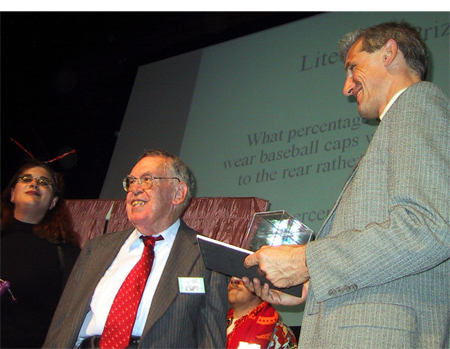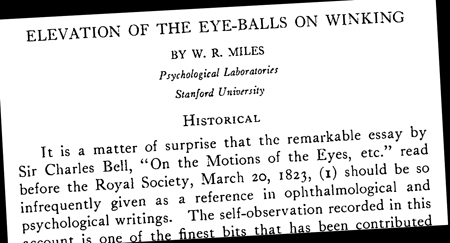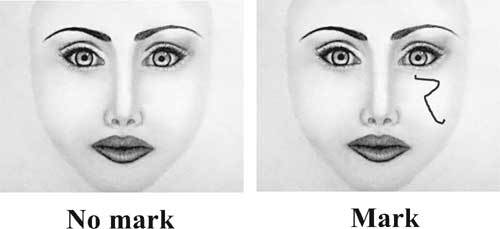Marc Abrahams's Blog, page 203
November 21, 2017
Research about winking, and news about Ig Nobel events in Europe
This month’s mini-AIR research spotlight scrutinizes this study about winking:
“Elevation of the Eye-Balls on Winking,” W.R. Miles, Journal of Experimental Psychology, vol. 14, no. 4, Aug 1931, pp. 311-332. The research was done at Stanford University.
That study and other bits of improbable research news congest the November issue of mini-AIR.
mini-AIR is the wee, free monthly supplement to the magnificent magazine Annals of Improbable Research. Get it by email, or read it our web site.

“Gross Appearance of Turkey Cloacae” [research study]
Turkeys are not much celebrated for their beauty. This study exemplifies that non-celebration:
“Gross Appearance of Turkey Cloacae Before and After Single or Multiple Manual Semen Collections,” M.R. Bakst and H.C. Cecil, Poultry Science, vol. 62, no. 4, April 1, 1983, pp. 683-9. The authors explain:
“The gross appearance of the turkey cloaca was examined before and after single or multiple semen collections. All cloacae exhibited some degree of hemorrhage formation, the extent of which was dependent upon 1) frequency of semen collection, 2) number of cloacal strokes, and 3) individual differences in semen collectors’ techniques. Cloacae of males subjected to multiple semen collections of more than four cloacal strokes per semen collection were the most severely injured.”
(Thanks to Becky Williams and Tim Arnow for bringing this to our attention.)
BACKGROUND: Here is a discussion, by students from the Animal Science 200 class at the University of Alberta, about semen collection from turkeys and other animals. The discussion begins with the question, “What is AI?”:

November 20, 2017
Improbable products (with mistakes) increase product preferences (research study)
“[…] we find that consumers actually prefer products that were made by mistake to otherwise identical products that were made intentionally.”
– explain the researchers behind a new study to be published in the Journal of Consumer Research. The research team performed a series of experiments which described to participants various mistake-prone scenarios, e.g. one in which a chef who was making lasagna sauce accidentally added two teaspoons of cinnamon to his recipe (rather than cumin). The results showed that the prospective consumers had a preference :
“We find that this preference is driven by the perception that a product made by mistake is more improbable than a product made without a mistake. This perceived improbability increases product uniqueness perceptions and subsequent preference.”
see: Made by Mistake: When Mistakes Increase Product Preference
Note: The illustration shows a test scenario from the study, in which participants were told two stories :
“in the mistake condition, they learned that the artist accidentally dropped his ink pen while drawing the face, marking the cheek. In contrast, in the intention condition, participants read that the artist decided to add a mark on the cheek while drawing the face.”
Bonus Assignment [optional] Do you prefer products that have mistakes in them? Or perhaps you prefer products with no mistakes? If you do have a preference, let us know by commenting below.

November 17, 2017
Ultrasound Probe Grip: The Afternoon Tea Technique
British tea traditions continue to affect the way medicine is taught and practiced. A new study pours out details.
“Ultrasound Probe Grip: The Afternoon Tea Technique,” Luke McMenamin, Stephen Wolstenhulme, Max Hunt, Stuart Nuttall, and Asoka Weerasinghe, Journal of the Intensive Care Society, vol. 18, no. 3, 2017, pp. 258-260. The authors, at medical institutions in Leeds and Dewsbury, explain:
“To encourage medical students and trainees to adopt effective probe ‘etiquette’, to prevent poor probe stability, caused by a pencil/pinch-grip (Figure 1), and improve image quality, the ‘afternoon tea technique’ was devised as a teaching method. Classically in Victorian Britain, the fifth finger was held out whilst drinking tea in aristocratic households. Therefore, the notion of ‘afternoon tea’ and the concept of ‘keeping your little finger’ in contact with the patient’s skin was created (Figure 2) in a bid to keep the probe stable whilst carrying out the procedure.”

November 16, 2017
Seriously Silly Design Fictions (study)
What would be the point of designing and developing “Magic Machines” in the form of a “Poo Detector” …

Or an “Eyes and Ears” gizmo? …
One reason would be to draw attention to the effects of so-called ‘Solutionism’ – prevalent in today’s world where technological ‘solutions’ (esp. gadgets) are constantly presented to solve problems that, previously, no-one really knew they had.
Mark Blythe, who is Professor of Interdisciplinary Design at Northumbria University, UK, specialises in examining such things as ‘Design Fictions’ and ‘Pretendotypes’ and was lead author of the paper ‘Anti-Solutionist Strategies: Seriously Silly Design Fiction’ presented at CHI ’16 Proceedings of the 2016 CHI Conference on Human Factors in Computing Systems, pp. 4968-4978, San Jose, California, USA — May 07 – 12, 2016.
“This paper has identified a number of practices which reject the search for solutions and deliberately seek to create unuseless, partial or silly objects. It has argued that although critical design and design fiction offer alternative aims for design (critique, commentary) the practice must move beyond satire and irony.”
A full preprint copy of the paper is available here.
BONUS: An example from the plethora of ‘Useless Machine’ videos available on YouTube ‘Another Advanced Useless Machine’

November 14, 2017
Three Computer Keyboards Operated by Hissing
Hissing might be a means of operating equipment, suggests this study:
 “,” Ondřej Poláček [pictured here], Zdeněk Mikovec, and Pavel Slavik, in Proceedings of the 2nd IASTED International Conference Assistive Technologies, 2012, pp. 862-9. The authors, at Czech Technical University in Prague, report:
“,” Ondřej Poláček [pictured here], Zdeněk Mikovec, and Pavel Slavik, in Proceedings of the 2nd IASTED International Conference Assistive Technologies, 2012, pp. 862-9. The authors, at Czech Technical University in Prague, report:
“This strategy is demonstrated on three virtual keyboards operated by hissing – a novel interaction method suitable for severely motor impaired people with speech impairments. An experiment with 39 users was conducted to compare the keyboards to three existing scanning keyboards. The participants were able to enter a text by hissing at the speed of 10-16 characters per minute.”
Here’s further detail from the study:

Techniques in Saliva Collection: Bacon Smell Rules, Lozenge Drools
Certain studies are tongue in cheek. This certain study is interested in the fluids between the tongue and cheek. Mouthwatering science abounds in the article, “New Techniques for Augmenting Saliva Collection: Bacon Rules and Lozenge Drools.”
Hoping to find a method that increases the rate mouth fluids can be collected, researchers had volunteers’ saliva analyzed on three different days under three different conditions:
On the basal day, participants provided 5 saliva samples. Saliva sampling began at a target time of 9:45AM, and the 4 subsequent samples were collected 15-minute intervals thereafter…On the lozenge day, participants returned to the laboratory and were administered one lozenge 25 minutes before sample collection, ensuring enough time for the lozenge to dissolve… On the bacon day, bacon was prepared via microwave 5 minutes before the participants arrived to allow the aroma to permeate the laboratory. Bacon was placed in front of the participants for 5 minutes before expectoration began at a target time of 9:45 AM, and a second sample was commenced 15 minutes after the first sample began.
The researchers generated the spitting image of a graph.
Both lozenge and the aroma of bacon significantly increase saliva flow and decrease saliva collection time. Many psychological and endocrinologic studies can use either of these 2 techniques for augmenting saliva collection.
The authors admit that having readily available cooked bacon smell may be tricky to obtain. Since other smells may also help increase saliva flow, the authors make a suggestion for future research:
Because viewing pictures of food is already a common method used in salivary research, perhaps examining the utility of scratch-and-sniff pictures might reveal saliva flow rate benefits to this aroma-based method.
The full citation: “New Techniques for Augmenting Saliva Collection: Bacon Rules and Lozenge Drools,” Jeremy C. Perez, Jacob L. Rouquette, Olga Miočević, Melissa C. Warner, Paul D. Slowey, Elizabeth A. Shirtcliff. Clinical Therapeutics, vol. 37(3), 2017, pp 515-522.`
Bonus: Bacon has been shown to have other medical uses. The 2014 Ig Nobel Medicine Prize was awarded for treating “uncontrollable” nosebleeds, using the method of nasal-packing-with-strips-of-cured-pork.

November 13, 2017
Elephant Trunk (new patent)
Robert Dale Beadles of Lodi, California, US, has just been granted a new US patent. Clues to its intended function can be seen in the drawing : 704 being a handle, and 703 being a wheel.
“In summary, the present container for items and personal effects for travel will be seen to provide not only a useful container for the transportation of goods, but also serve as a fashion accessory for people of all ages. The container is also easy to use, and provides for a more ergonomic option as it only requires gentle pulling to activate the rear leg wheel system for the transportation of the container. When the tension has been released to a preset tension, the rear leg wheel system will retract, and the container resembling an animal will ‘sit down,’ and can also provide other entertainment at the time with other gestures such as panting, yawning, or wagging its tail, for example.”
Note that the invention will also be applicable to dogs, whales &etc. For more explanations and drawings of the other animals see US patent 9,788,619, October 17, 2017, entitled simply ‘Suitcase’.

November 12, 2017
Sad news: Trinkaus is out for the count
John Trinkaus, who was awarded the 2003 Ig Nobel literature prize, for meticulously collecting data and publishing more than 80 detailed academic reports about things that annoyed him, died. His family notified us today.
John (who enjoyed jokingly referring to himself as “Trinkaus”) was one of New York’s overlooked treasures. We became friends after he won his Ig Nobel Prize. Trinkaus loved to explain that he did all those studies for the satisfaction of doing them—not to amass academic credit. He published the first of those reports, he said, after he had gotten tenure. He was a professor at the Zicklin School of Business, in New York City.
One of the most unusual things about Trinkaus was that he, mostly, simply counted how many times the annoying things happened. Unlike many academics, Trinkaus did not search for imaginative theories about the things he counted. Here’s a photo of Trinkaus (center) accepting his Ig Nobel Prize (a plexiglas cube containing a nanogram of gold) from Nobel laureate Wolfgang Ketterle. Ig Nobel minordomo Julia Lunetta is at left:
Here are a few of the studies of things that annoyed John Trinkaus:
What percentage of young people wear baseball caps with the peak facing to the rear rather than to the front
What percentage of pedestrians wear sport shoes that are white rather than some other color
What percentage of swimmers swim laps in the shallow end of a pool rather than the deep end
What percentage of automobile drivers almost, but not completely, come to a stop at one particular stop-sign
What percentage of commuters carry attaché cases
What percentage of shoppers exceed the number of items permitted in a supermarket’s express checkout lane
What percentage of students dislike the taste of Brussels sprouts.
Eighty-six of of Trinkaus’s publications are listed in “Trinkaus—An Informal Look,” which appeared in the Annals of Improbable Research, vol. 9, no. 3 (the special Everything issue), May/Jun 2003.
You can watch video of Trinkaus receiving the Ig Nobel Prize, and delivering his acceptance speech.
Trinkaus did some of his finest work after winning his Ig Nobel Prize. The most celebrated was a series of studies in which he documented that most children seemed indifferent about visiting Santa Claus at a shopping mall — and that the kids’ parents, unlike the kids, were excited.
To the best of our knowledge, no academic has followed Trinkaus’s lead in carefully, relentlessly documenting things that annoy them, tallying exactly how frequently those things occur.
If there is a heaven, it will now learn exactly how many angels can dance on the head of a pin.
BONUS: The year after Trinkaus was awarded his Ig Nobel Prize, he returned to the ceremony and took part in that year’s mini-opera. You can watch him dancing the can-can as part of that opera’s final song, about the coffee diet.
BONUS: In 2004, Fortune magazine asked me to write about Trinkaus. I began that article with this question: “Does one man count for nothing?“

Richard Nixon’s inauguration day haul of dead pigeons
 “In his previous inauguration, Nixon had noticed that there were a large number of birds in the trees, and didn’t like the thought of being pooped on as he drove down the National Mall in Washington DC in an open-top limo. Nixon ordered that the pigeons were to be removed – and so the US government spent some $13,000 on a pest spray, Roost-No-More, to get rid of the offending birds.”
“In his previous inauguration, Nixon had noticed that there were a large number of birds in the trees, and didn’t like the thought of being pooped on as he drove down the National Mall in Washington DC in an open-top limo. Nixon ordered that the pigeons were to be removed – and so the US government spent some $13,000 on a pest spray, Roost-No-More, to get rid of the offending birds.”
Polly Chapman tells the tale, in Chemical World‘s “Chemistry In It’s Element” podcast.
BONUS FACT: The 2003 Ig Nobel Prize for chemistry was awarded to Yukio Hirose of Kanazawa University, for his chemical investigation of a bronze statue, in the city of Kanazawa, that fails to attract pigeons.

Marc Abrahams's Blog
- Marc Abrahams's profile
- 14 followers









